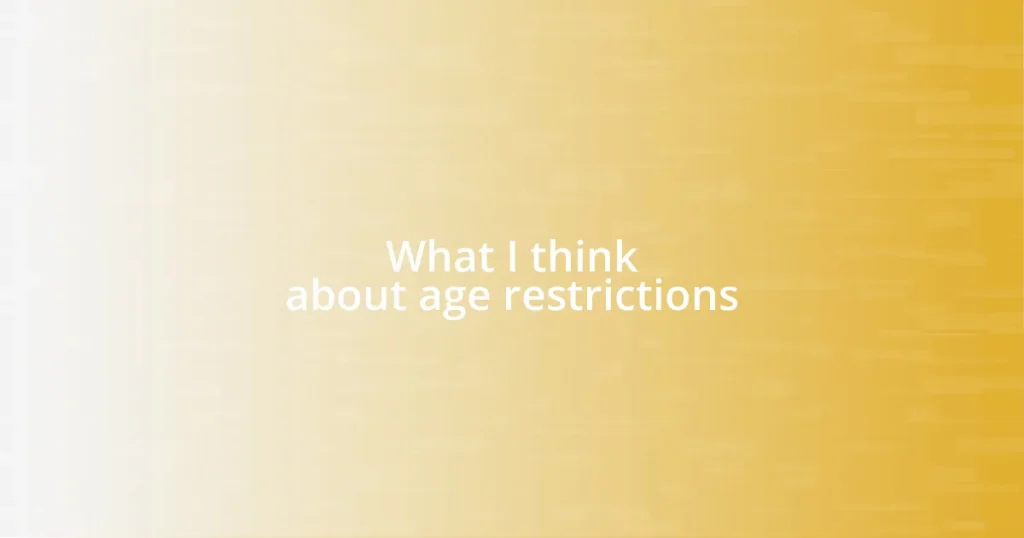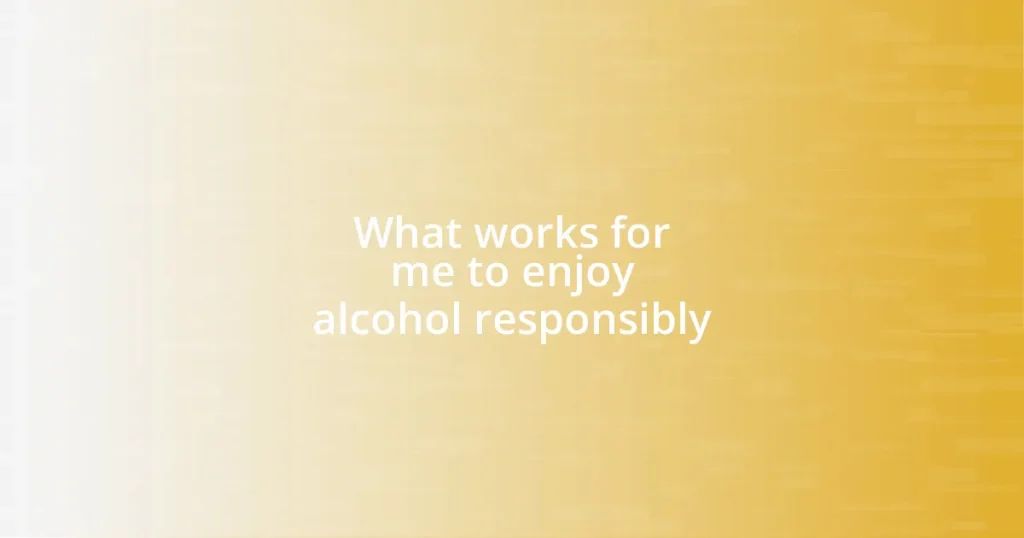Key takeaways:
- Age restrictions serve to protect young individuals by guiding them towards age-appropriate content and fostering meaningful discussions about values.
- Different contexts, such as movies, video games, and social media, have varying age restrictions tailored to the maturity levels of the audience.
- Arguments exist both for and against age restrictions, highlighting the need for a balance between protection and allowing personal responsibility and exploration.
- Individual maturity should be considered over rigid age guidelines to create a supportive environment conducive to development and creativity.
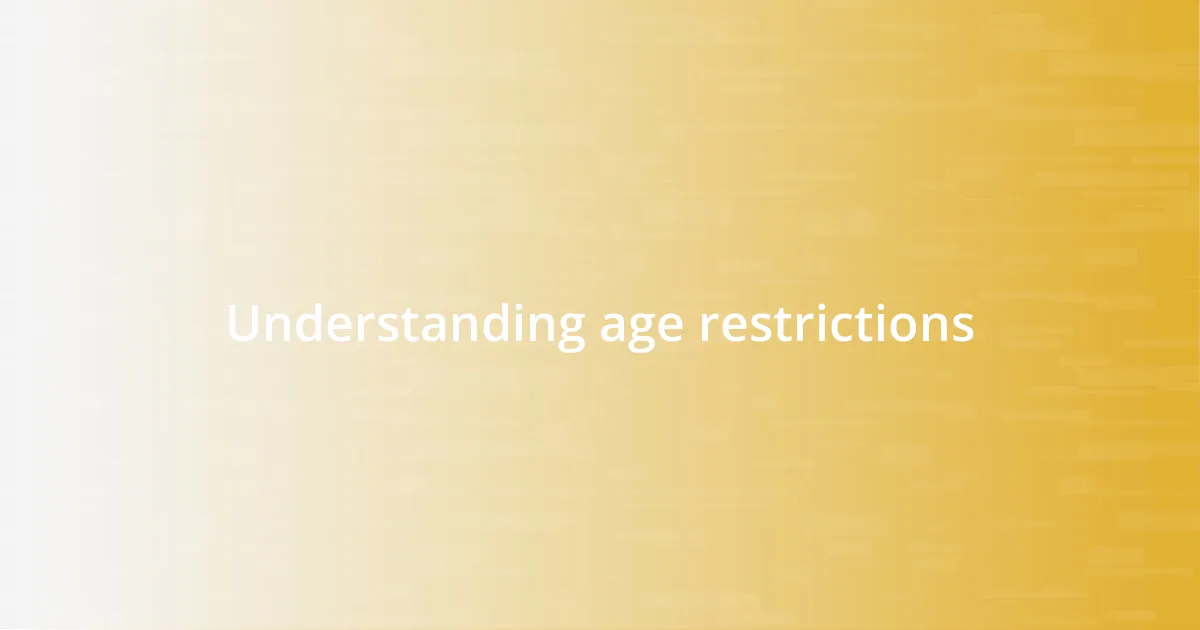
Understanding age restrictions
Age restrictions often serve as a guideline to protect younger individuals from content that may be inappropriate or harmful for their developmental stage. I remember when my younger cousin wanted to watch a film that was rated R. She was insistent, saying, “It’s just a movie!” But as I explained to her, age ratings consider not just the content but how it might affect someone who hasn’t yet developed the tools to process complex themes.
Sometimes, I find myself reflecting on my own childhood experiences with age restrictions. I vividly recall sneaking into movies that were beyond my age range, feeling both exhilarated and guilty. It’s interesting how those forbidden films shaped my understanding of boundaries and taught me about responsibility, isn’t it?
Debates about age restrictions often raise questions about balancing safety and freedom. What’s the right age to expose young minds to challenging themes? In my experience, having open conversations about why certain content is restricted can offer clarity and foster understanding, rather than simply enforcing rules.
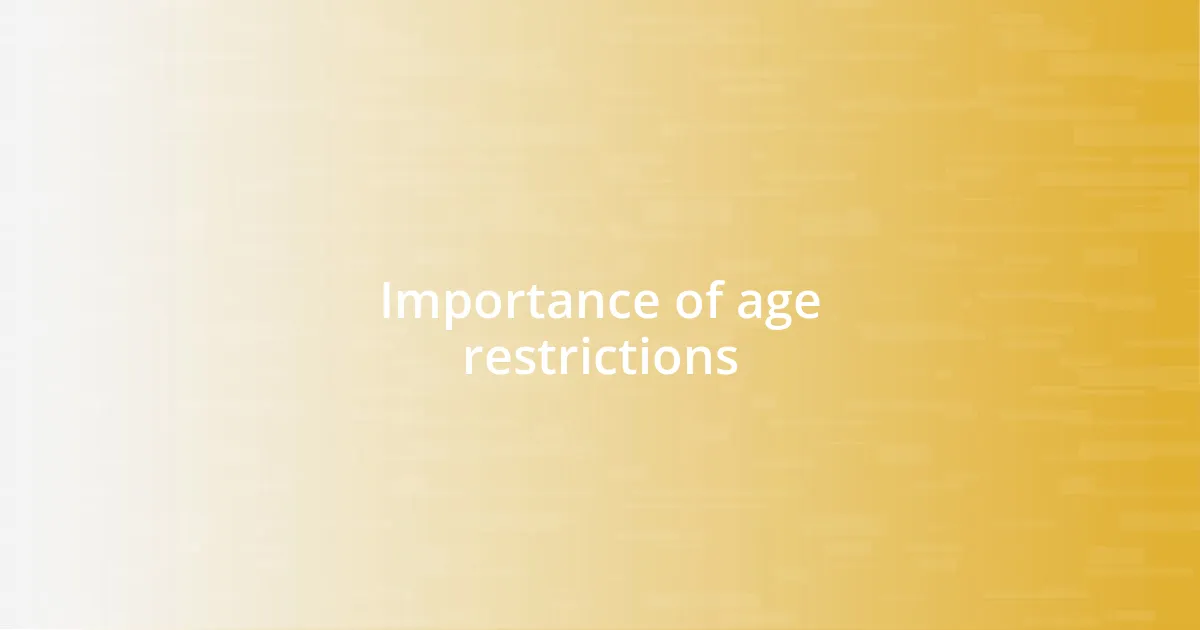
Importance of age restrictions
Age restrictions play a crucial role in guiding young people towards age-appropriate content. I believe they act as a protective barrier, giving parents and guardians peace of mind. I still remember when I was about ten and desperately wanted to read a popular fantasy series that my friends were raving about. My mom gently pointed out that some themes were a bit too dark for me at that age, and while it felt frustrating, I appreciate her foresight now. Age restrictions are about preserving innocence and enabling conversations rather than just saying “no.”
- They help shield children from harmful or confusing material.
- They create opportunities for meaningful discussions about content and values.
- They recognize the varying levels of maturity in children and adolescents.
- They assist in developing critical thinking about media consumption.
- They establish a framework for parents to navigate entertainment choices.
Ultimately, age restrictions are there to foster a safe environment while nurturing curiosity.
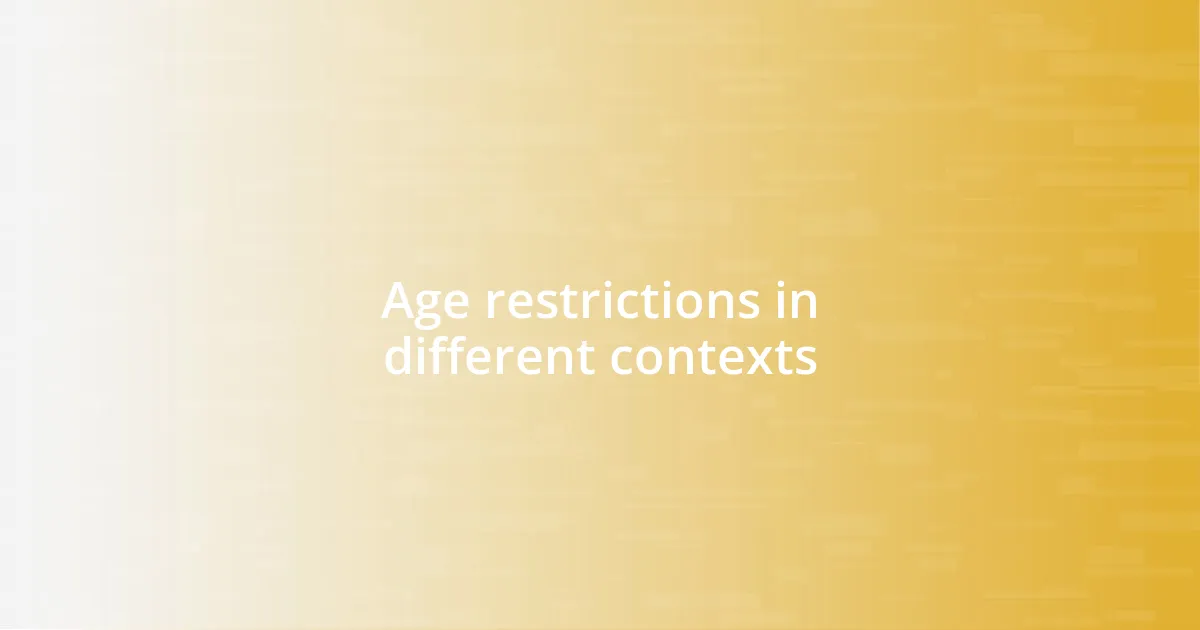
Age restrictions in different contexts
Age restrictions vary significantly across different contexts, each aimed at addressing specific concerns. For instance, I often think about video games, where age restrictions can feel a bit more flexible than movie ratings. I remember playing games like “Grand Theft Auto” in high school that were rated M for mature audiences. At the time, it seemed silly that such a label would stop younger players from diving into a rich world of storytelling and strategy. Yet, as I reflect on it, I appreciate the thought behind those ratings—it’s all about ensuring that players engage with content that aligns with their maturity levels.
When it comes to online platforms, age restrictions can be even more complex. I once signed up for social media at a surprisingly young age, and those early interactions were eye-opening, yet often overwhelming. There’s a reason platforms like Facebook and Instagram set the minimum age at 13: to protect younger users from a sometimes harsh digital landscape. I think age restrictions here are less about limiting access and more about safeguarding emotional well-being and privacy in a space that’s full of potential dangers.
Lastly, let’s look at age restrictions in the context of alcohol and tobacco. I’ve always found it fascinating that while certain movies are viewed by anyone regardless of age, substances like alcohol have strict regulations. At a gathering, I distinctly remember seeing friends react differently to these substances—with some having their first sip at a legal age, while others were much more cautious. I believe these restrictions actually teach responsibility and respect for personal choice, showing that age can signify readiness to handle life’s more serious choices.
| Context | Typical Age Restriction |
|---|---|
| Movies | Varies (e.g., G, PG, PG-13, R) |
| Video Games | EC, E, E10+, T, M |
| Social Media | 13+ |
| Alcohol/Tobacco | 21+ |
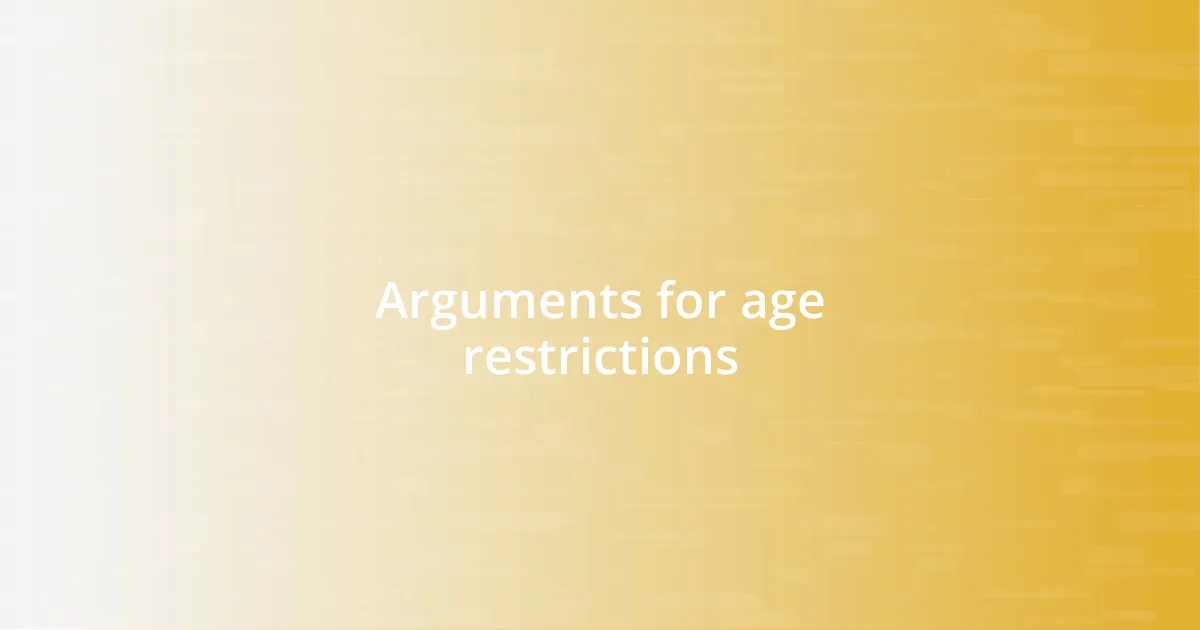
Arguments for age restrictions
When I think about age restrictions, I immediately recognize their value in shielding young minds from potentially harmful content. For example, I vividly remember the first time I stumbled upon a horror film that my friends were raving about. I was curious, but my parents wisely advised against it, explaining how such themes could linger uneasily in a young imagination. Looking back, I appreciate that they prioritized my mental well-being, helping me avoid experiences that might have been too intense for my age.
Another compelling argument for age restrictions lies in their role as a catalyst for important conversations. Consider the conversations sparked between parents and children about the morals depicted in certain films or video games. I remember discussing a recent movie with my dad that had some tough themes, and it opened the door to a deep conversation about right and wrong. Isn’t it fascinating how these age guidelines can help adults guide their children through complex societal values, ultimately preparing them for the world ahead?
Moreover, age restrictions acknowledge that children develop at different rates. For instance, I’ve watched my younger siblings engage with digital content, and it’s clear that their maturity levels vastly differ. My younger brother, at eight, isn’t ready for the same material that my sixteen-year-old sister can handle. I can’t help but wonder: how often do we underestimate the importance of tailoring experiences to different ages? Age restrictions provide a framework that allows varying levels of emotional and cognitive understanding, fostering a more supportive environment for growth.
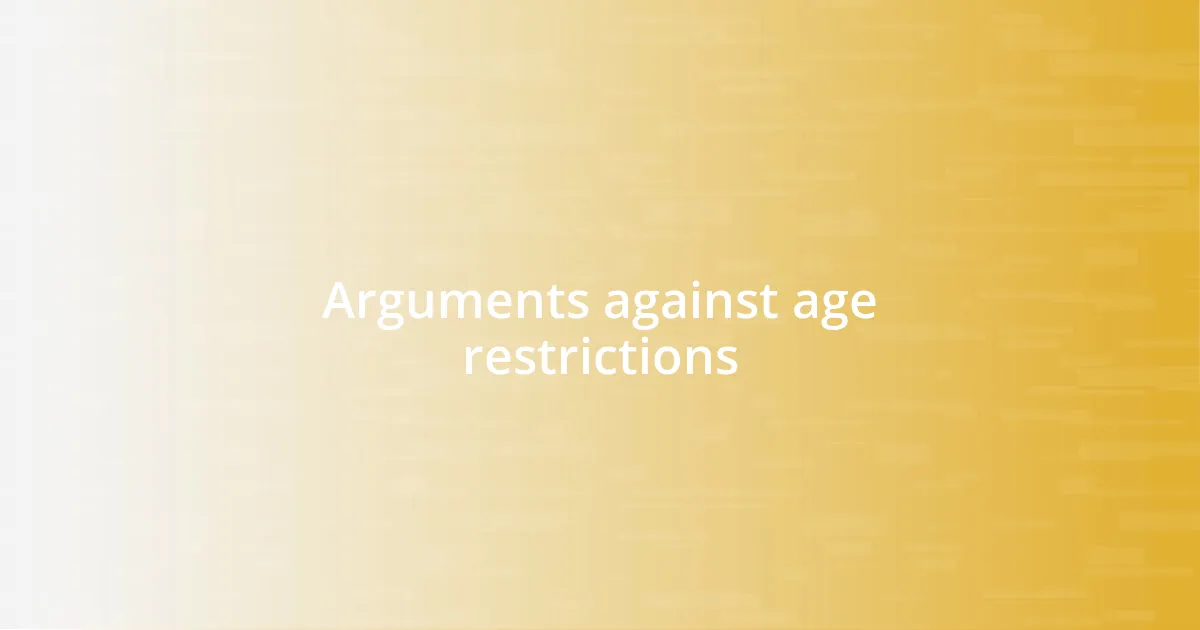
Arguments against age restrictions
When I consider the arguments against age restrictions, I often think of the creativity and exploration that young minds can bring to the table. I vividly remember sneaking into a rated R film with friends when I was a teen. While it might have been frowned upon, the experience opened my eyes to diverse perspectives and storytelling techniques. It made me realize that, in some cases, age restrictions could limit access to art and ideas that could inspire and encourage critical thinking.
Another aspect I ponder is the idea of personal responsibility. I recall a heated debate with my peers about whether age should dictate what we can and cannot consume. It’s intriguing to me that while we trust teenagers to drive vehicles and make significant decisions, we still impose strict guidelines on what they can view or play. By removing some of these restrictions, we’d offer a chance for young people to learn how to make choices for themselves—a vital skill for adulthood.
Moreover, in our fast-paced digital world, age restrictions might feel increasingly archaic. I still remember the day I joined an online gaming community, surprised to find such a mix of ages and viewpoints in the chat rooms. Wouldn’t it be more beneficial to foster open dialogue among all ages rather than segregating them? Engaging with differing perspectives could cultivate empathy and understanding, which feel especially important in today’s polarized society. There’s so much potential in having these discussions if we allow for greater interaction between age groups.

Finding a balanced approach
Finding a genuinely balanced approach to age restrictions means considering both the protective intent and the freedom of expression. I remember the summer my friends and I organized movie nights, carefully curating our selection. While some films were too intense for our younger siblings, there were others that sparked laughter and imagination across all ages, proving that not every viewing experience needs a strict label. How do we create an environment where such joy can flourish while also keeping sensitive content at bay?
I often reflect on the importance of parental guidance in this dialogue. My parents didn’t just enforce rules; they involved me in discussions about what I was watching. When I questioned why certain films were off-limits, they shared insights into their reasons, and those conversations stuck with me. Isn’t it fascinating how fostering a dialogue can empower young people to understand and discern their media choices rather than simply restricting them? It’s all about balance—allowing space for exploration while also setting the framework for healthy engagement.
At the same time, I believe we must recognize that each child is unique. I saw this firsthand watching my cousin, who, despite being younger, tackled complex narratives with ease. It led me to wonder: should we not have a more flexible approach that considers individual maturity rather than a one-size-fits-all model? Crafting age restrictions shouldn’t be about blanket guidelines but rather thoughtfully navigating the landscape of development, understanding, and creativity.










